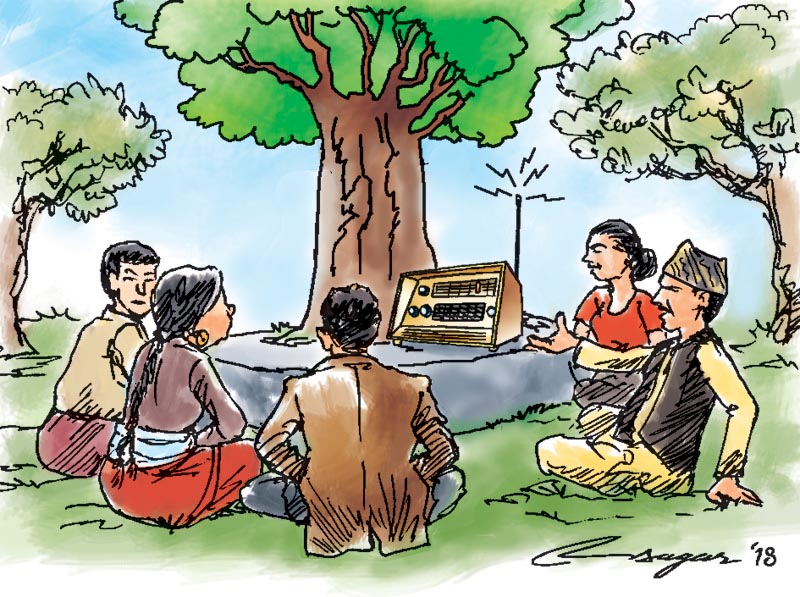Tune into radio: Role of mass medium in Nepal
Community radios have been working for social transformation by informing and empowering communities. FM radios are the best tools to pass information to illiterate and rural communities, for all the people can listen to the radio for free
The World Radio Day is celebrated annually on February 13. So this year, it will be the seventh World Radio Day after it was proclaimed by the United Nations Assembly in 2011. The theme for the World Radio Day this year is “Radio and Sports”.
The world Radio Day also marks the anniversary of the first broadcast by UN Radio in 1946, when it transmitted its first call sign: “This is the United Nations calling the peoples of the world.” The Day seeks to raise awareness about the importance of radio, facilitate access to information through radio and enhance networking among broadcasters.
Since radio is the mass medium reaching the widest audience in the world, it is recognised as a powerful communication tool and a low cost medium. Radio is specifically suited to reach remote communities and vulnerable people: the illiterate, the disabled, women, youth and the poor, while offering a platform to intervene in the public debate, irrespective of people’s educational level. Furthermore, radio has a strong and specific role in emergency communication and disaster relief.
Community and local FM radios played a vital role in Nepal in the aftermath of the devastating earthquakes of April and May 2015. The earthquakes mainly affected 14 districts of Nepal, causing nearly 9,000 deaths, massive destruction of infrastructure including individual. There was widespread displacement of people due to the quakes. And radio stations were no exception. A number of radio stations were affected and vital equipment damaged. Radio stations from the 14 affected districts suffered the most. A number of radio journalists were injured at a time they had to work round the clock. People could not watch news on TV and newspapers did not reach the affected communities on time. But community radios continued their broadcast even during those difficult times. They proved extremely helpful when it came to disseminating information about the people in need and providing relief materials.
FM radios contributed in their own ways. FM radios, which aim to give voice to the voiceless, aspire to create an informed and just society and strive for social transformation. They are important vehicles to build and strengthen inclusive democracy and development. More than 400 radio stations, which are working in diversified communities and reaching more than 90 percent of total population, aim towards this goal.
Though it is the youngest media product, FM radio has rapidly developed across Nepal. It is serving the people of remote rural areas and the disadvantaged communities which lack access to other media forms such as newspapers and television.
Community radios have been working for the past 19 years for social transformation — by informing, educating and empowering communities, particularly the disadvantaged, oppressed and illiterates. FM radios are the best tools to pass information to illiterate and rural communities, for all the people can listen to the radio for free.
Community radios reach the powerless communities and give them a voice. They create awareness and promote consciousness about development. FM radios have also been playing the role of civil surveillance agencies. They have encouraged people to acquire public information for protection and promotion of citizen rights. They encourage people to exercise their right to information, thereby generating dynamic public feedback on social issues. Nepal’s radio service was in government control until 1993. The National Media Policy (1992) and National Broadcasting Act (1993) are landmark documents for they, for the first time, allowed commercial radio broadcasting. Similarly, the National Broadcasting Regulations (1995) defined the processes and methods for establishing FM stations. Frequency Modulation (FM) radio technology started in 1995 which paved the way for the private sector to start radio communication.
Kathmandu FM, the first FM channel covering the Kathmandu Valley and adjoining areas, came into being in 1995. But obtaining broadcasting license was still hard back then. The Nepal Forum of Environmental Journalists (NEFEJ) had to struggle hard to obtain license for Radio Sagarmatha in 1997. Radio Sagarmatha finally went on air on May 19, 1997 becoming the first community radio in Nepal. It also established Nepal as the first country with community radio in South Asia. It thus became the first non-government and non-commercial radio station.
Above 300 stations, spread across 77 districts, are broadcasting today. But there is still poor legal and policy framework for community radios. But still community radios have not been able to work for actively for community development and accountable local government. Often government authorities treat them as private media entities. There is a gap in understanding among our policy makers, mass media professionals and community radio promoters over scopes of public, private and community media.
Ideally, there should be a separate Act to regulate community radios. Due to its absence, community radios were registered as private media entities. Community radios promote rights to information and freedom of expression and opinion in the communities they serve. We thus need a regulatory framework for community radios.
Acharya is chief of Community Radio Network






